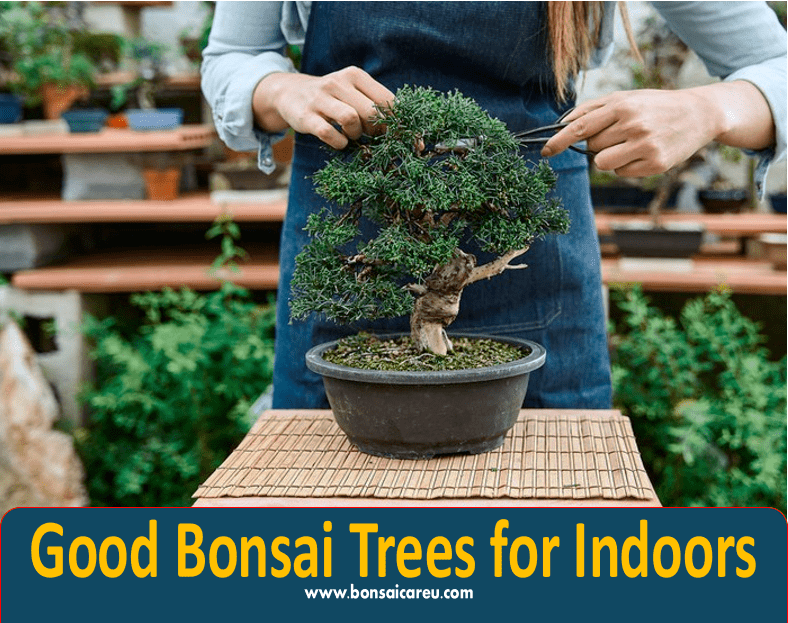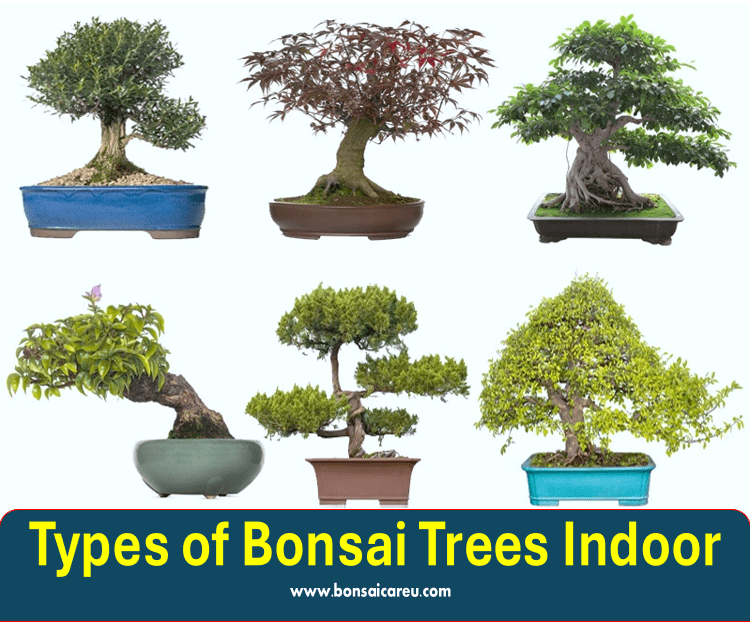Good Bonsai Trees for Indoors: For good bonsai trees for indoors, consider the Ficus, Jade, or Chinese Elm varieties. These options are well-suited for indoor environments due to their tolerance for low light levels and ability to thrive in a controlled setting.
Bonsai trees provide a unique and artistic touch to any indoor space, bringing a sense of tranquility and natural beauty. With proper care and maintenance, these miniature trees can add a touch of Zen to your home or office. When considering which bonsai tree to choose, factors such as size, ease of care, and aesthetic appeal should all be considered.
By selecting a suitable indoor bonsai tree, you can enhance your living or working environment with a touch of nature and artistry.

1. Benefits Of Indoor Bonsai Trees
Bonsai trees have long been admired for their beauty, artistry, and cultural significance. Regarding indoor gardening, bonsai trees offer a unique and captivating way to bring nature into your home. In addition to their aesthetic appeal, indoor bonsai trees offer a range of benefits that make them a delightful addition to any living space.
Air Purification
Indoor bonsai trees act as natural air purifiers, removing toxins and impurities from the surrounding environment and releasing oxygen into the air. This natural process improves the air quality within your home and creates a healthier and more refreshing atmosphere for you and your family.
Stress Reduction
The presence of indoor bonsai trees can help reduce stress and anxiety by creating a calming and serene environment. Caring for these miniature trees can be therapeutic, offering a meditative and relaxing experience that promotes mindfulness and mental well-being.
2. Factors To Consider For Indoor Bonsai Trees
2.1 Lighting Conditions
Bonsai trees require adequate lighting to thrive indoors.
- Place your bonsai tree near a bright window without direct sunlight.
- Rotate the tree regularly to ensure even light exposure on all sides.
2.2 Humidity Levels
Maintaining optimal humidity levels is essential for indoor bonsai trees.
- Use a humidity tray filled with water to increase moisture around the plant.
- Mist the leaves regularly to prevent dryness in low-humidity environments.
3. Top Picks For Indoor Bonsai Trees
For those looking to bring the beauty of bonsai trees indoors, here are the top three picks that thrive in indoor environments and make stunning additions to any home.
Ficus Bonsai
The Ficus Bonsai, also known as the Weeping Fig, is popular for indoor bonsai enthusiasts. The Ficus adds elegance and charm to any room with its glossy leaves and distinctive trunk.
Jade Bonsai
Jade Bonsai, characterized by its thick, pristine leaves and the symbolic significance of good luck, is a low-maintenance indoor bonsai option perfect for beginners and experienced growers.
Chinese Elm Bonsai
Chinese Elm Bonsai is a versatile option that thrives in indoor settings. With its fine branching and beautiful green foliage, the Chinese Elm is appreciated for its natural beauty and serene appearance.

4. Care Tips For Indoor Bonsai Trees
Welcome to the fourth section of our guide to good bonsai trees for indoors: Care Tips for Indoor Bonsai Trees. Proper care is essential for the health and longevity of your indoor bonsai trees. In this section, we will outline key care tips, including watering techniques, pruning and shaping, and fertilizing.
4.1 Watering Techniques
When watering your indoor bonsai tree, it is important to strike a balance. Over-watering can lead to root rot, while under-watering can cause the tree to dry out and die. The best way to water your bonsai is to check the soil moisture regularly. Use your finger to check the top inch of soil – if it feels dry, it’s time to water. Ensure the water penetrates the entire root ball by watering thoroughly until water flows out of the drainage holes at the bottom of the pot. Avoid waterlogging by allowing excess water to drain out completely.
4.2 Pruning And Shaping
Pruning and shaping are essential for maintaining the health and aesthetics of your indoor bonsai tree. Begin by choosing the right tools for the job, such as sharp scissors or bonsai shears. Regularly prune away dead, damaged, or crossing branches to promote healthy growth and improve the tree’s shape. Use wiring techniques to guide the growth of branches and create the desired bonsai form. Regular maintenance is key to keeping your indoor bonsai tree looking its best.
4.3 Fertilizing
Indoor bonsai trees require regular fertilizing to thrive. Choose a balanced liquid fertilizer formulated specifically for bonsai trees, and follow the instructions carefully. Fertilize the tree every two to four weeks during the growing season and reduce frequency during the dormant winter months. Avoid over-fertilizing, as this can damage the tree’s delicate roots. Be mindful of the tree’s nutritional needs to ensure healthy, vibrant growth.
5. Decorating With Indoor Bonsai Trees
Indoor bonsai trees not only infuse an element of nature into your home, but they also make for stunning decorative pieces. Bonsai trees are a captivating addition to any room with their miniature size and unique structures. In this section, we will explore how to enhance the beauty of your indoor space with these mesmerizing creations.
5.1 Choosing The Right Pot
When choosing the right pot for your indoor bonsai tree, it is essential to consider aesthetics and functionality. The pot you select should complement the tree’s natural beauty and provide adequate drainage for optimal growth and health. Here are some key factors to keep in mind:
- Choose a pot that is proportionate to the size of your bonsai tree. The pot shouldn’t overpower the tree’s beauty but enhance its visual appeal.
- Opt for a clay or ceramic pot, as these provide better breathability and moisture regulation for the roots than plastic containers.
- Ensure the pot has drainage holes at the bottom to prevent waterlogging, which can lead to root rot.
- Consider the shape and color of the pot to create a harmonious balance between the tree’s foliage and the room’s overall aesthetic.
5.2 Placement And Display
Placement and display play a crucial role in showcasing the true essence of your indoor bonsai tree. Here are some tips to help you create an eye-catching display:
- Find a suitable location in your home that provides light and temperature for your specific bonsai tree species.
- Ensure the tree receives indirect sunlight for a few hours each day. Avoid placing it in direct sunlight, as it can scorch the delicate foliage.
- When deciding where to place your bonsai tree, consider the overall aesthetics of the room. It can serve as a centerpiece on a coffee table, a focal point on a shelf, or an accent piece on a windowsill.
- Use decorative elements like rocks, moss, or figurines to enhance the display’s visual appeal. These additions can create a natural-looking landscape around the bonsai tree.
- Rotate the tree occasionally to ensure even growth and prevent the branches from leaning towards the light source.
Decorating with indoor bonsai trees brings your living space a unique sense of serenity and tranquility. Choosing the right pot and placing the tree in an ideal location can create a captivating decorative display that brings nature indoors.

6. Troubleshooting Common Indoor Bonsai Issues
When caring for indoor bonsai trees, it’s important to be aware of common issues that may arise. By promptly addressing these concerns, you can help maintain the health and beauty of your bonsai tree. This section will explore two common problems: pest control and yellowing leaves.
6.1 Pest Control
Pests can be a nuisance for indoor bonsai trees, but you can effectively manage them with the right knowledge and action. Here are some tips for pest control:
- Regularly inspect your bonsai tree for signs of pests such as aphids, mealybugs, or spider mites.
- Isolate any affected tree from your other bonsai trees to prevent the pests from spreading.
- Clean the leaves and branches of your bonsai tree with a soft cloth or brush to remove any visible pests.
- Introduce beneficial insects like ladybugs or lacewings to help control pest populations.
- Use organic pest control products or neem oil spray to treat infestations. Follow the instructions carefully.
- Maintain a clean environment around your bonsai tree, removing any fallen leaves or debris that could harbor pests.
6.2 Yellowing Leaves
Yellowing leaves can be a sign of various issues affecting the health of your indoor bonsai tree. Here are some possible causes and solutions:
Root Rot: Overwatering or poor drainage can cause root rot, leading to yellowing leaves. To address this, ensure proper drainage by repotting your bonsai in well-draining soil. Adjust your watering schedule as needed, allowing the soil to dry slightly between watering sessions.
Underwatering: Insufficient watering can also result in yellowing leaves. Check the moisture level of the soil regularly, and water your bonsai tree when the top inch feels dry. Avoid overwatering.
Nutrient Deficiency: Lack of essential nutrients can cause yellowing leaves. Using a balanced bonsai fertilizer according to the instructions can help provide the necessary nutrients and promote healthy foliage.
Pest Infestation: Pests like aphids or spider mites can suck the sap from leaves, causing them to turn yellow. If you notice signs of pest damage, follow the pest control tips in section 6.1.
Lighting Issues: Insufficient or excessive light can affect leaf color. Ensure your bonsai receives the optimal amount of light for its specific species. If natural light is limited, consider using grow lights.
Temperature Stress: Extreme temperature fluctuations can lead to yellowing leaves. Maintain a stable temperature around your bonsai tree, away from drafty areas or temperature extremes.
Troubleshooting these common issues will equip you to keep your indoor bonsai trees thriving and looking their best.
Frequently Asked Questions On Good Bonsai Trees For Indoors
What Is The Best Bonsai Tree To Grow Indoors?
The best bonsai tree to grow indoors is the Ficus Retusa, which thrives in low-light conditions and is easy to care for.
What Is The Best Beginner Bonsai Tree?
The best beginner bonsai tree is the Ficus or Chinese Elm. They are easy to care for and forgiving of mistakes. Both Ficus and Chinese Elm are resilient and adaptable, making them ideal for beginners.
Is It OK to Keep A Bonsai Tree Indoors?
It is generally acceptable to keep a bonsai tree indoors as long as it receives adequate light, humidity, and proper care. Place it near a window for enough sunlight and maintain the appropriate watering and pruning routine to keep it healthy.
Where Should I Put My Bonsai Tree In My House?
Place your bonsai tree in a spot with plenty of natural light and stable temperature. Avoid direct sunlight and drafts. Choose a location that complements the aesthetic of your home and provides easy access for watering and maintenance.
What Are The Best Bonsai Trees For Indoors?
Bonsai trees like Ficus, Jade, and Juniper thrive indoors with proper care and lighting.
How Often Should Indoor Bonsai Trees Be Watered?
Water indoor bonsai trees when the top layer of soil feels dry to the touch.
Conclusion
There are several great options for indoor bonsai trees, each with unique charm and characteristics. Whether you prefer the classic Ficus Bonsai or the elegant Chinese Elm, there is a perfect choice for every indoor space. With the right care and attention, these bonsai trees will bring beauty and tranquility to your home.


